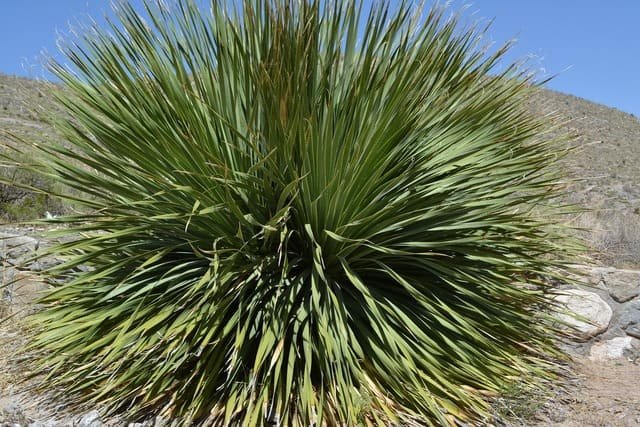Yucca plants are hardy, drought-tolerant, and stunning additions to outdoor gardens. However, while they can thrive in challenging conditions, they are not immune to certain problems.
If you’re growing yucca outdoors, you might face issues like pest infestations, fungal infections, overwatering, and even sunburn (yes, even sun-loving plants can suffer from too much sun!). Let’s dive into these common problems and, more importantly, how you can tackle them effectively.

1. Pesky Pests: Uninvited Guests on Your Yucca
Yucca plants are relatively resistant to pests, but that doesn’t mean they’re completely safe. Here are some of the most common pests that can trouble your outdoor yucca:
Yucca Weevils:
These critters lay eggs in the plant’s crown, and the larvae bore into the stem, causing wilting and eventual collapse. If your plant starts to droop for no apparent reason, inspect the base for signs of infestation.
Solution: Remove infected parts immediately and apply neem oil or insecticides designed for weevils. Encouraging natural predators like ladybugs can also help. If the infestation is severe, you may need to replace the soil to eliminate any eggs.
Mealybugs & Scale Insects:
These sap-suckers weaken your plant, causing yellowing leaves and stunted growth. They tend to hide in the crevices of leaves, making them tricky to spot early on.
Solution: A strong jet of water can dislodge them. For persistent infestations, use rubbing alcohol on a cotton swab to wipe them off or apply insecticidal soap. Introducing beneficial insects like lacewings can also be an effective long-term solution.
Spider Mites:
If you notice fine webbing and speckled leaves, you’ve got mites. They thrive in dry conditions and can spread quickly if not controlled.
Solution: Regularly rinse the leaves and increase air circulation around your plant. If the infestation is bad, use neem oil or miticides. Keeping your yucca dust-free can reduce the chances of mites establishing themselves.
2. Fungal Infections: The Silent Killer
Fungal diseases can creep in when outdoor conditions are too damp, causing serious damage to your yucca. It often starts small but can quickly spread if not addressed.
Leaf Spot:
Characterized by brown or black spots on leaves, often caused by excess moisture or poor air circulation.
Solution: Remove affected leaves and ensure good air circulation. Avoid overhead watering and apply a fungicide if necessary. Copper-based fungicides work well in preventing further spread.
Root Rot:
Overwatering is the number one culprit behind root rot, leading to mushy, blackened roots and an overall sickly plant. This condition often goes unnoticed until the plant shows clear signs of decline.
Solution: If caught early, trim off affected roots and amend outdoor soil with well-draining materials. Prevent recurrence by letting the soil dry out completely between waterings. Adding sand or perlite to your soil mix can improve drainage and prevent future issues.
3. Overwatering: The #1 Killer of Yucca Plants
Yucca plants despise wet feet! Overwatering leads to root rot, yellowing leaves, and even plant death. Many gardeners make the mistake of treating yucca like other tropical plants, which need more moisture.
Solution: Only water when the top 2-3 inches of soil are completely dry. If you’re unsure, it’s better to underwater than overwater. Use well-draining soil and ensure proper drainage in your garden. Be mindful of seasonal changes—yucca needs even less water during colder months.
Signs of Overwatering: Aside from yellowing leaves, overwatering can lead to a soft, mushy stem. If you notice an unpleasant odor near the roots, that’s a strong indication of rot. You might also see small mushrooms or mold growth on the soil surface, which signals excessive moisture retention.
4. Sunburn: Yes, It’s a Thing!
Yucca plants love the sun, but if they suddenly experience extreme heat or harsh direct sunlight after being in partial shade, they can get sunburned. Even mature outdoor yuccas can suffer during heatwaves.
Signs: Leaves may develop white or brown patches, indicating sun damage. In severe cases, the tips of the leaves may dry out and become brittle.
Solution: Gradually acclimate your yucca to full sun if it was previously in shade. Provide temporary shade during extreme heatwaves. If you live in an area with scorching summers, planting yucca where it gets partial afternoon shade can prevent sunburn.
Preventative Measures: Mulching around the base can help retain moisture without overwatering. Additionally, watering in the early morning rather than midday can help reduce heat stress.
5. Cold Damage
Yuccas are generally hardy, but some varieties struggle with freezing temperatures. If you live in an area with harsh winters, your yucca might experience leaf browning, blackened tips, or even dieback. Sudden frost can especially harm young plants, stunting their growth.
Solution:
- Choose a cold-hardy variety like Yucca filamentosa or Yucca gloriosa if you’re in a cooler climate.
- Protect the plant with a frost blanket or burlap during extreme cold spells.
- If leaves get damaged, wait until spring before pruning; the damaged foliage can help insulate the plant.
- Planting yuccas near a sunny wall or in a spot sheltered from harsh winter winds can help minimize frost damage.
6. Overgrowth & Lack of Pruning
Yucca plants grow fast, and if left unchecked, they can become an overgrown, spiky mess. Older leaves can dry out, giving the plant an untidy look, and in some cases, the tall flower stalks can collapse under their weight.
Solution:
- Prune off dead or damaged leaves regularly to maintain a clean appearance.
- If your yucca is too tall, you can cut the trunk and let new growth sprout from the base.
- Remove spent flower stalks once they dry out to prevent them from toppling over.
7. Improper Soil & Nutrient Deficiency
While yuccas don’t require much fertilizer, poor soil conditions can slow their growth and make them more susceptible to disease. Heavy clay soil can suffocate the roots, while nutrient-poor soil can cause slow or stunted growth.
Solution:
- Use a sandy or rocky soil mix to promote proper drainage.
- If growing in clay soil, amend with coarse sand or gravel.
- Occasionally fertilize in the spring with a balanced, slow-release fertilizer, but avoid overfeeding as too much nitrogen can cause weak, leggy growth.
8. Transplant Shock
If you recently moved your outdoor yucca and noticed it looking droopy, it might be experiencing transplant shock. The plant may lose leaves or stop growing as it adjusts to its new environment.
Solution:
- Water sparingly and avoid fertilizing until the plant has settled in.
- Keep an eye on the roots when transplanting to avoid damaging them.
- If moving a yucca to a different sun exposure, do so gradually to help it adjust.
Final Thoughts
While yucca are tough, they still require care and attention. The key to a thriving yucca is balance—adequate sunlight, well-draining soil, and minimal watering. Keep an eye out for pests and fungal infections, and act quickly when you spot trouble. With the right approach, your outdoor yucca will stay healthy and beautiful for years to come!
Growing yucca outdoors is a rewarding experience, and with a little bit of knowledge, you can prevent many of the common pitfalls. Have you faced any of these issues with your yucca plants? Let us know your experiences and tips in the comments below!



